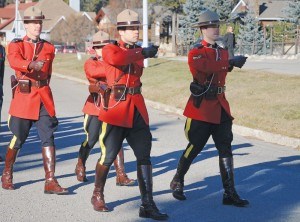 Jasper is now home to a high-powered, semi-automatic weapon.
Jasper is now home to a high-powered, semi-automatic weapon.
Late last year, Acting Sergeant Ryan Gardiner was trained to use a C8 patrol carbine—a rifle similar to an M-16—and he now has one in town, in case of a serious emergency.
The RCMP has been deploying these weapons to front-line RCMP officers since 2011. The decision to purchase and disperse the guns was in response to the 2005 deaths of four Mounties in Mayerthorpe, Alta. and has been reinforced by more recent events, such as the 2014 Moncton shootings, which saw three officers killed and two severely injured.
In 2011, William Elliot, who was the RCMP commissioner at the time, said in a memo that the rifles would fill gaps in the organization’s “operational firearms capabilities.”
Last month, Gardiner spoke about the short-barrelled, lightweight assault rifle, as well as his training with it, during a council meeting.
He told council that times are changing and the RCMP has to keep up in order to ensure the safety of its officers and the public.
“Fifteen years ago I didn’t think I’d be wearing a military type vest with military type ammunition on, but things are changing and that’s the way it’s going, so we have to have those capabilities here,” he said.
Describing his training, which he underwent in Regina last November, Gardiner said he was taught to fight with the C8.
“Some of the drills are seven rounds in seven seconds, engaging multiple targets in the body and the head, so you’re really thinking and you’re really firing this gun.
“It’s going to be a very bad situation if I ever have to deploy those tactics or techniques,” he said. “But we do have that capability and it is good to see that we do have it, considering what you see going on in the world.”
Gardiner noted that Jasper might feel like an isolated bubble, but he and his colleagues have to remain vigilant.
“Certainly I don’t think that we should take the view that we’re immune to it or it couldn’t happen here. There’s lots of communities that have said it wouldn’t happen there and it has,” he said, referring to mass shootings and terrorist attacks.
“Our threat level is high and we’re being very vigilant for that, and I think people across the country have to be vigilant for that.”
Although Gardiner admitted that Jasper hasn’t seen any terrorist activities in the past, he encouraged the public to come forward if they do notice anything out of the ordinary.
“We’re starting to see radicalization of people to ISIS and again people are starting to see people in their communities.
“If you see somebody maybe we can intervene early enough before they do something that wouldn’t be good.
“I ask the public, if they have anything suspicious, report it to us, let us investigate it and follow up on it.”
The use of C8 carbines and ceramic-plated ballistic vests was recommended in an inquiry into the 2005 deaths of four RCMP officers near Mayerthorpe, Alta.
The officers were guarding a marijuana grow-op when they were shot with high-powered bullets from a semi-automatic military assault rifle.
As a result, Constables Anthony Gordon, Leo Johnston, Brock Myrol and Peter Schiemann died.
In a report on their deaths, Alberta provincial court Judge Daniel Pahl said the RCMP was “heavily outgunned” and recommended greater access to long-barrelled weapons and carbines.
More recently, there was another call for Mounties to be better armed last summer, following Justin Bourque’s shooting spree in Moncton, which killed three officers and injuring two others.
In a report drafted after the event, the RCMP was urged to expedite the deployment of patrol carbines across the force.
The carbine is a lightweight assault rifle that can be used at greater distances, with greater accuracy, than standard-issue pistols and shotguns.
Describing it to council, Gardiner explained that it’s a rifle with “a lot of fire power and capability.
“The gun that I have is equipped with optics on the top, so I can shoot at quite a distance and it’s very accurate, even in close quarters combat; you can dial the red dot scope down so you can use it in close quarters.
“It’s a very good use of machinery and a lot of money was spent by the federal government to get those for us.”
Nicole Veerman
[email protected]
